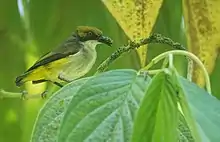Olive-capped flowerpecker
The olive-capped flowerpecker (Dicaeum nigrilore) is a species of bird in the family Dicaeidae. It is endemic to the island of Mindanao in the Philippines.Its natural habitat is tropical moist montane forest.
| Olive-capped flowerpecker | |
|---|---|
 | |
| Nominate subspecies seen in South Cotobato. | |
| Scientific classification | |
| Domain: | Eukaryota |
| Kingdom: | Animalia |
| Phylum: | Chordata |
| Clade: | Dinosauria |
| Class: | Aves |
| Order: | Passeriformes |
| Family: | Dicaeidae |
| Genus: | Dicaeum |
| Species: | D. nigrilore |
| Binomial name | |
| Dicaeum nigrilore Hartert, 1904 | |
Description and taxonomy
EBird describes the bird as "A small, rather long-billed bird of montane forest on Mindanao. Olive-green on the back, darker on the edge of the wing, with a golden-olive head, a pale gray throat separated from the head color by a black line, a pale gray chest, and pale yellow on the sides and under the base of the tail. Note the black legs and the red eye. Somewhat similar to olive-backed flowerpecker, but has a longer bill and a yellowish lower belly. Voice includes a high-pitched upslurred whistle and a rough 'jiik!'"[2] Often seen feeding on fruiting and flowering trees.
Subspecies
Two subspecies are recognized.
- Dicaeum nigrilore nigrilore found in West, Central and Southern Mindanao has a more visible yellow rump
- Dicaeum nigrilore diuatae found in Northeast Mindanao has an overall darker green and drabber color and a greenish yellow rump.
A possible third subspecies which has a yellowish-green head is found in Southeast Mindanao. Further study is needed on this potential subspecies.[3]
Habitat and conservation status
It inhabits tropic moist sub-montane and montane forest above 900 masl.
IUCN has assessed this bird as a least-concern species. Despite a limited range, it is said to be locally common in its range. As it occurs in rugged and inaccessible mountains, this has allowed a large portion of its habitat to remain intact. However, there it is still affected by habitat loss through deforestation, mining, land conversion and slash-and-burn - just not to the same extent as lowland forest. [4]
References
- BirdLife International (2016). "Dicaeum nigrilore". IUCN Red List of Threatened Species. 2016: e.T22717497A94535614. doi:10.2305/IUCN.UK.2016-3.RLTS.T22717497A94535614.en. Retrieved 11 November 2021.
- "Olive-capped Flowerpecker". Ebird.
- Allen, Desmond (2020). Birds of the Philippines. Barcelona: Lynx and Birdlife International Field Guides. pp. 348–349.
- International), BirdLife International (BirdLife (2016-10-01). "IUCN Red List of Threatened Species: Dicaeum nigrilore". IUCN Red List of Threatened Species. Retrieved 2021-09-09.
